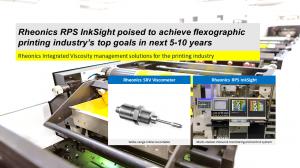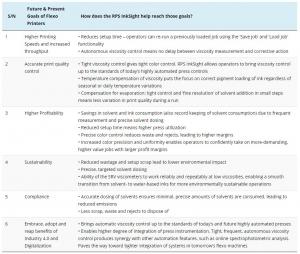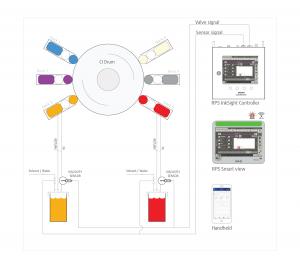Rheonics RPS InkSight poised to revolutionize color control in flexographic printing
The multi-station ink viscosity automation system enables tightest color control, makes the printing operations more efficient and sustainable.
Flexographic printing has a number of advantages over traditional printing presses. It has a faster startup time and can print using a wide variety of ink on almost any substrate – plastics, metallic films, cellophane, paper, and even on corrugated surfaces. In the last 20 years, the flexographic printing process has experienced a rapid technological evolution and today it is one of the most popular printing technologies within the packaging and flexible packaging industries.
As per a report from Smithers, it is expected that the global value of flexographic printing will rise from $167.7 billion in 2020 to $181.1 billion in 2025 driven by package and label printing as well as sanitary/kitchenware. The fastest growing regional markets are Asia and Eastern Europe. Quality, versatility, affordability, rapid printing speeds, faster changeovers and connectivity compatibility are some of the reasons why flexographic printing is the technology of choice today and will maintain a lead in the future.
2. Key expected trends in flexo printing industry
- Steady, constant market growth is expected. Flexographic printing is a constantly growing market and is expected to rise in line with packaging market growth.
- Main market growth driver: Dynamic packaging print sector. In the coming 5-10 years, majority of growth is expected from the dynamic packaging print sector, where new automation and hybrid press lines are giving flexographers more flexibility and possibility to explore higher-value print applications.
- Most cost effective for mid– to long-runs. Though flexo remains most cost-effective print process for mid- to long-runs, continuous developments in digital printing will increase market pressures on flexo to address changing consumer demands.
- Automation and improvements in CtP and digitalization adoption for profitability. To respond to changing consumer demands, particularly for more short-run work, the flexo printers will need to increase automation of their presses, make improvements in computer to plate (CtP) processing and use digital workflows.
- Sustainability focus of flexographers. The adoption of more sustainable printing solutions, led by water-based ink sets, and LED UV curing is expected, in order to minimize environmental damage.
3. Goals of flexo-printing companies over the next 5-10 years
Keeping in mind the expected industry trends, the goals of flexographers over the next few years are:
- Higher print speeds and increased throughput: Shorter time to finish a job and to shorten job times. Ability to complete more jobs.
- Highest print product quality: Achieving color accuracy reliably, repeatably, and complying with brand owners’ changing quality expectations.
- Higher profitability: Using technology and data to optimize scale, volumes, quality and product differentiation. Increasing the lifetime of expensive printing machines using data.
- Sustainability: Reduced wastage and setup scrap; improve savings in solvent and ink consumption
- Compliance: Meet increasingly stringent environmental norms in terms of solvent consumption, CIP requirements, emissions as well as operators’ safety.
- Embrace, adopt and reap benefits of Industry 4.0 & Digitalization: Maximize utility of acquired printing process data combined with full traceability and information transparency.
Key global players in the packaging printing market are Amcor (NYSE:AMCR), Ball (NYSE:BLL), International Paper (NYSE: IP), Mondi (LON: MNDI), Sealed Air (NYSE: SEE), Smurfit Kappa (OTCMKTS: SMFTF), WestRock (NYSE: WRK), DS Smith (LON: SMDS), Graphic Packaging (NYSE: GPK), Packaging Corporation of America (NYSE: PKG), American Packaging Corporation, Interprint, Sonoco (NYSE: SON) served by international printing press manufacturers like Bobst (SWX: BOBNN), Windmöller & Höllscher, Comexi, Cerruti, Soma, Barry Wehmiller (PCMC, BW Papersystem), Koenig & Bauer, Komori, Ryobi, Dover Corp, Hewlett-Packard (NYSE: HPQ), Xerox (NYSE: XRX), WIFAG.
4. What is Rheonics Printing Solution RPS InkSight?
RPS InkSight is a highly accurate Multi-station ink viscosity control system. It consists of three subsystems, a viscosity sensor, a predictive tracking controller, and a powerful, intuitive graphical interface. It delivers color excellence through extremely tight viscosity control.
RPS InkSight Page on Rheonics website
5. What is unique about Rheonics viscosity control?
Traditional viscosity measuring methods (like efflux cups) are inaccurate, tedious to use, and prone to errors. Continuous viscosity control with such methods is extremely inefficient and unproductive. Many common viscosity measuring devices do not provide fine enough viscosity control and require high maintenance and frequent calibration. Rheonics RPS InkSight Predictive Tracking Controller and SRV viscometers enable tight viscosity control throughout the print job, due to the the system’s ability to autonomously maintain viscosity within extremely narrow limits. Printers can achieve unmatched color accuracy and quality with the RPS InkSight system and ColorLock software – which is designed in collaboration with printers, for printers.
Read an user case study, "Viscosity standardization in flexographic printing" - Open the case study on rheonics blog
To download the brochure: RPS InkSight Flexo Printing Brochure
6. About Rheonics
Rheonics is a global automation provider of robust plug and play instruments for viscosity and density monitoring, two of the key physical properties of a process fluid. Rheonics viscometers and density meters meet a wide variety of measurement challenges in the most demanding and aggressive environments. Customers can select from standard solutions based on our established technologies, or partner to develop bespoke solutions for their applications. Rheonics sensors and solutions are used by industry leaders in packaging (printing), chemicals, life sciences, medical, food, beverage, and other process industries.
Other global players in the USD 200+ billion industrial process automation industry are Emerson (NYSE: EMR), ABB (SWX: ABBN), Honeywell (NYSE: HON), Siemens (ETR: SIE), Rockwell Automation (NYSE: ROK), Yokogawa (TYO: 6841), Schneider Electric (EPA: SU), Danaher (NYSE: DHR). The market growth is driven by increased adoption of industry 4.0 in manufacturing industries and increased penetration of Industrial IoT across the complete industrial ecosystem.
Manpreet Dash
Rheonics GmbH
+41 52 511 32 00
email us here
Visit us on social media:
Facebook
Twitter
LinkedIn
RPS InkSight System Demonstration Video
Legal Disclaimer:
EIN Presswire provides this news content "as is" without warranty of any kind. We do not accept any responsibility or liability for the accuracy, content, images, videos, licenses, completeness, legality, or reliability of the information contained in this article. If you have any complaints or copyright issues related to this article, kindly contact the author above.



